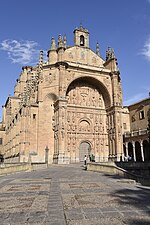Salamanca

Salamanca (Spanish pronunciation: [salaˈmaŋka]) is a municipality and city in Spain, capital of the province of the same name, located in the autonomous community of Castile and León. It is located in the Campo Charro comarca, in the Meseta Norte, in the northwestern quadrant of the Iberian Peninsula. It has a population of 144 436 registered inhabitants (INE 2017). Its stable functional area reaches 203 999 citizens, which makes it the second most populated in the autonomous community, after Valladolid. Salamanca is known for its large number and remarkable Plateresque-style buildings. The origins of the city date back to about 2700 years ago, during the first Iron Age, when the first settlers of the city settled on the San Vicente hill, on the banks of the Tormes. Since then, the metropolis has witnessed the passage of various peoples: Vaccaei, Vettones, Romans, Visigoths and Muslims. Raymond of Burgundy, son-in-law of King Alfonso VI of León, was in charge of repopulating the city during the Middle Ages and laying the foundations of modern-day Salamanca. Salamanca is home to the oldest active university in Spain, the University of Salamanca, founded in 1218 by Alfonso IX of León on the germ of its studium generale, and which was the first in Europe to hold the title of university by royal decree of Alfonso X of Castile dated November 9, 1252 and by the licentia ubique docendi of Pope Alexander IV of 1255. During the time when it was one of the most prestigious universities in the West, the phrase Quod natura non dat, Salmantica non præstat, What nature does not give, Salamanca does not lend, became popular. Salamanca is linked to universal history by names such as Antonio de Nebrija, Christopher Columbus, Fernando de Rojas, Francisco de Vitoria and the School of Salamanca, friar Luis de León, Beatriz Galindo or Miguel de Unamuno. In 1988, the Old City of Salamanca was declared a World Heritage Site by UNESCO. It has an important historical-architectural heritage, among which stand out its two cathedrals - the Old cathedral and the New cathedral, the Casa de las Conchas, the Plaza Mayor, the Convento de San Esteban and the Escuelas Mayores. Since 2003, Holy Week in Salamanca has been declared of international tourist interest. Salamanca is home to important scientific institutions and research centers, such as the Cancer Research Center, the Institute of Neurosciences of Castile and León, the Center for Water Research and Technological Development and the Ultra-Short Ultra-Intense Pulsed Laser Center. The city and its metropolitan area, host some of the largest companies, by turnover, in the autonomous community of Castile and León. In addition, it is considered to be a world reference in the teaching of Spanish language, since it concentrates 78% of the existing offer in its autonomous community, which represents 16% of the national market.
Excerpt from the Wikipedia article Salamanca (License: CC BY-SA 3.0, Authors, Images).Salamanca
Calle Toro, Salamanca
Geographical coordinates (GPS) Address Nearby Places Show on map
Geographical coordinates (GPS)
| Latitude | Longitude |
|---|---|
| N 40.965 ° | E -5.6641666666667 ° |
Address
Plaza Mayor
Calle Toro
37002 Salamanca (Centro)
Castile and León, Spain
Open on Google Maps









